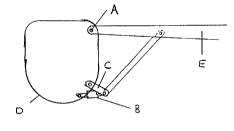Some of the information on this Web page has been provided by external sources. The Government of Canada is not responsible for the accuracy, reliability or currency of the information supplied by external sources. Users wishing to rely upon this information should consult directly with the source of the information. Content provided by external sources is not subject to official languages, privacy and accessibility requirements.
Any discrepancies in the text and image of the Claims and Abstract are due to differing posting times. Text of the Claims and Abstract are posted:
| (12) Patent Application: | (11) CA 2121823 |
|---|---|
| (54) English Title: | SOFT WING SUSPENSION |
| (54) French Title: | ELEMENT DE SUSPENSION D'AILE D'AVION |
| Status: | Dead |
| (51) International Patent Classification (IPC): |
|
|---|---|
| (72) Inventors : |
|
| (73) Owners : |
|
| (71) Applicants : | |
| (74) Agent: | |
| (74) Associate agent: | |
| (45) Issued: | |
| (22) Filed Date: | 1994-04-21 |
| (41) Open to Public Inspection: | 1995-10-22 |
| Availability of licence: | N/A |
| (25) Language of filing: | English |
| Patent Cooperation Treaty (PCT): | No |
|---|
| (30) Application Priority Data: | None |
|---|
Most aircraft currently being manufactured today use some
form of suspension system which will dampen the impact
forces of landing and bumps on the ground. None of the
airplanes manufactured today provide any means to dampen
any sudden flight loads or bumps while flying, except for
the flexing of the wing.
My invention is to provide a means to provide relative
movement between the fusealage and it?s supporting and
controling structures (wings, stabalizers) during flight.
It will also provide means to control the rate, neutral
position and amount of movement these surfaces are allowed.
By doing this the passengers in the airplane will enjoy
a smoother ride, and fatigue loads on the entire airplane
structure will be reduced. Inspection times and airframe
life could be extended as it is known that aircraft which
fly through turbulant air regularly (pipe line patrol)
have shorter inspection times and airframe life. The
dampened movement of the wing would also allow floats,
wheels or skiis to be mounted directly to the bottom of
the wing, which can now be used to absorb landing loads.
Note: Claims are shown in the official language in which they were submitted.
Note: Descriptions are shown in the official language in which they were submitted.

For a clearer understanding of the status of the application/patent presented on this page, the site Disclaimer , as well as the definitions for Patent , Administrative Status , Maintenance Fee and Payment History should be consulted.
| Title | Date |
|---|---|
| Forecasted Issue Date | Unavailable |
| (22) Filed | 1994-04-21 |
| (41) Open to Public Inspection | 1995-10-22 |
| Dead Application | 1997-04-21 |
There is no abandonment history.
| Fee Type | Anniversary Year | Due Date | Amount Paid | Paid Date |
|---|---|---|---|---|
| Application Fee | $0.00 | 1994-04-21 |
Note: Records showing the ownership history in alphabetical order.
| Current Owners on Record |
|---|
| DAWSON, PAUL WESLEY |
| Past Owners on Record |
|---|
| None |